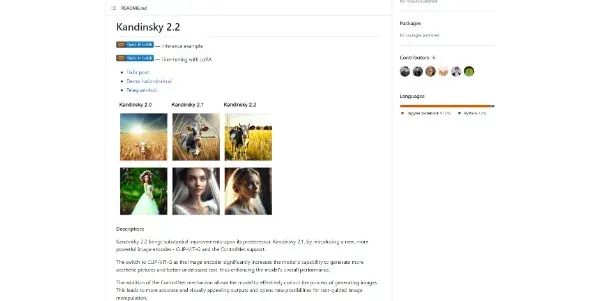Kandinsky 2

A promising open-source project for high-quality image generation (Text2Image)
Kandinsky 2: A Deep Dive into the Open-Source Text-to-Image Generator
Kandinsky 2 is a rapidly evolving, open-source project making significant strides in the field of text-to-image generation. This powerful tool allows users to create high-quality images from simple text descriptions, offering a compelling alternative to several proprietary options. Its accessibility and continuous development make it a noteworthy contender in the increasingly competitive AI art generation landscape.
What Kandinsky 2 Does
At its core, Kandinsky 2 is a Text-to-Image (T2I) generator. This means it translates natural language prompts into visually rich images. You input a text description – for example, "a majestic lion standing on a snow-capped mountain at sunset" – and the AI interprets the prompt, generating a corresponding image. The remarkable aspect of Kandinsky 2 is its ability to produce images with a high level of detail, artistic style, and overall coherence, often surpassing the capabilities of earlier open-source models.
Main Features and Benefits
High-Quality Image Generation: Kandinsky 2 stands out for its ability to generate images with superior detail and fidelity compared to some other open-source alternatives. This is particularly noticeable in the rendering of textures, lighting, and intricate details within the generated scenes.
Open-Source Nature: Being open-source, Kandinsky 2 fosters community involvement and transparency. This allows developers to inspect the model's architecture, contribute improvements, and adapt it for specific use cases. This also translates to potential for faster innovation and evolution compared to proprietary models.
Ease of Use: While some technical understanding may be beneficial for advanced customization, the core functionality of Kandinsky 2 is relatively user-friendly. The process of providing a text prompt and generating an image is straightforward.
Style Control (potential): Though still under development, future iterations likely will enhance the ability to guide the artistic style of the generated images, allowing users greater control over the aesthetic outcome.
Use Cases and Applications
The applications of Kandinsky 2 are vast and expanding:
- Content Creation: Generating illustrations for articles, books, websites, social media posts, marketing materials, etc.
- Game Development: Rapid prototyping of game assets, environments, and character concepts.
- Art & Design: Exploring creative ideas, generating inspiration, and creating unique artistic pieces.
- Education: Teaching AI concepts, exploring the intersection of art and technology, and facilitating creative expression.
- Product Design: Quickly visualizing product concepts and variations before committing to physical prototyping.
Comparison to Similar Tools
Kandinsky 2 occupies a unique space within the text-to-image landscape. Compared to commercial options like Midjourney or Dall-E 2, it offers the significant advantage of being free and open-source. However, it may lag slightly behind in terms of certain features, such as the level of stylistic control offered by some commercial competitors or the overall image quality in some complex scenarios. Compared to other open-source projects, Kandinsky 2 often demonstrates a competitive advantage in terms of the quality and detail of its generated images. The ongoing development of Kandinsky 2 promises to further close this gap.
Pricing Information
Kandinsky 2 is completely free to use. As an open-source project, there are no licensing fees or subscription costs associated with its usage. This makes it an exceptionally accessible tool for a broad range of users and applications.
Conclusion:
Kandinsky 2 represents a significant step forward for open-source text-to-image generation. While it's still under development, its current capabilities and the potential for future enhancements make it a compelling option for individuals and organizations seeking a powerful, free, and versatile tool for image creation. Its open-source nature encourages community involvement and ensures its continued evolution and improvement, promising an exciting future for this promising technology.